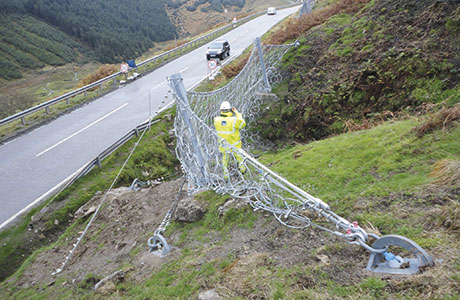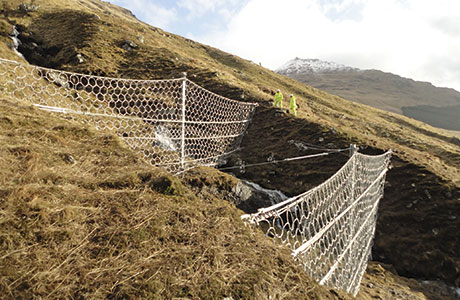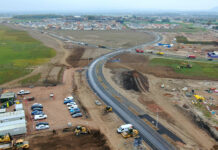
INSTALLATION of an extensive network of debris flow barriers at the Rest and Be Thankful pass in Argyll & Bute could prevent lengthy diversions.
The Rest and Be Thankful carries the busy A83 trunk road between Arrochar and Inveraray through mountainous terrain in the west of the country. The pass has suffered frequent debris flows, especially over the last seven years.
When the road is closed, a diversion of roughly 50 miles is required. As the A38 trunk road crosses an area of outstanding natural beauty around the Rest and Be Thankful, which is part of the Loch Lomond and Trossachs National Park, Transport Scotland required that any debris flow prevention measures had to have a minimal visual impact on the surrounding landscape.
The area suffers high levels of rainfall which act as the trigger for failure. Movement of the surficial soils usually starts high on the hillside and is progressively channelled into natural gullies above the road, forming a debris flow.
By the time the flow has reached the road it has gathered sufficient material, including large boulders, to completely inundate the carriageway. It has also developed sufficient translational kinetic energy to cause damage to any vulnerable structures, vehicles or people that it may strike. Consequently, debris flows represent a considerable risk which must be mitigated.
Chris Gell, of Consulting Engineers Waterman [Perth] who is leading the design of the current phase of work in association with rockfall protection specialists Maccaferri, explained the challenges faced by the design team.
“Because of the remote location on steep and unstable ground, the measures had to be easily installed with the minimum of heavy plant and machinery. Variable depth to rock head required a range of barrier foundation and anchor designs to account for differing ground conditions.”
The barrier installation work builds on detailed geomorphological assessments by Geomorph Consulting and additional surveys by locally based main contractor, Geo-Rope.
Due to the scale of the site, it was felt to be impractical to erect barriers along the whole length of the roadside. Costs would have been prohibitive and the barriers would also have created a hazardous physical obstacle to local wildlife.
For this reason, Maccaferri proposed a network of debris flow barriers totalling roughly 1500 sq m. The barriers are positioned in such a way as to conform to the site topography and offer the best balance of engineering performance and minimum cost/materials requirement. At the same time, they exceed the client’s requirement for volumetric impact capacity whilst creating a relatively small and discrete visual profile.
The barriers are loosely based on Maccaferri’s high capacity 3000kJ and 5000kJ RMC rockfall catch fence systems. They comprise hinged steel supporting posts from which heavy duty interceptor panels of steel-wire ring-mesh are suspended. Bracing cables, anchored laterally and up-slope, are equipped with patented aluminium energy dissipaters.
These act to minimise impact-induced shock loadings on the system in a controlled way and are specified on a rope-by-rope basis in debris flow systems. The dissipaters are also highly resistant to corrosion and according to Maccaferri, are simple to install.
Dr David Cheer, rockfall mitigation specialist for Perth-based Maccaferri, said, “Compared to Rock Fall Barrier projects, Debris Flow situations constitute a much more complex scenario. There are many more variables and all the time, we have to keep functionality and practicality of installation in mind. Debris Flow is a serious problem but one that can be addressed using the right technology and the correct technical approach.
“The geometric configuration and positions chosen for the barriers allowed us to reduce both the impacting forces and consequently the size and costs of the foundations and barrier anchorages. By carefully selecting the barrier locations it was possible to minimise the total requirement for barriers. This approach is more design-intensive but offers better value to the client compared to the “spread-shot” approach of protecting large lengths of road in a blanket fashion, hoping to intercept a flow.”
In this latest phases of work, ten bespoke debris flow barriers are being installed by roped access geotechnical contractor Geo-rope. Geo-rope specialises in complex geotechnical and rope access solutions and because of the difficult terrain, brought in a specially adapted helicopter to lift and place components of the 2.00m – 6.00m high barriers into position.
Performance of the barriers will be constantly monitored using a web hosted asset monitoring and data storage system developed for use with the Maccaferri systems by itmsoil. The instrumentation system will integrate real time remote monitoring and logging of barrier conditions and automatically triggered day/night photogrammetry.
This will provide data on barrier performance and condition while helping with network management and scheduling of unplanned maintenance events. The system is remotely controlled and adjusted with the ability to monitor slope and barrier conditions and take photographs of the area around the barriers.











